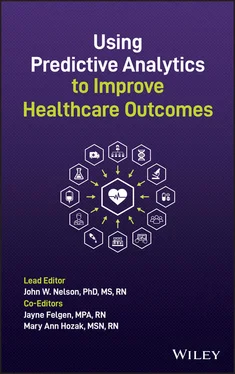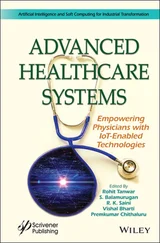Relationship with Self/Care of Self
To stay healthy and be emotionally available for others, clinicians must pay attention to their own energy levels, be self‐aware and mindful as they interact, and practice self‐care for body, mind, and spirit.
Relationship with Colleagues/Care of Colleagues
Healthy interpersonal relationships between colleagues positively impact the patient experience. All team members must model mutual respect, trust, open and honest communication, and consistent, visible support of one another.
Relationship with Patients and Families/Care of Patients and Families
In RBC cultures, patients are seen, heard, and cared for as distinct individuals. Care and service are designed to prevent unnecessary suffering due to delays, physical or emotional discomfort, and lack of information about what is happening. The care delivery system of Primary Nursing, which is explained later in this chapter, is used because it is the system most supportive of the nurse–patient relationship (Manthey, 1980; Wessel & Manthey, 2015).
Several chapters in this book document studies seeking to understand the relationship between care of self and/or the care of the unit manager and nurse job satisfaction.
Responsibility + Authority + Accountability (R+A+A)
The theoretical framework known as R+A+A has appeared in nearly every book Creative Health Care Management (CHCM), the originators or RBC, has published (Felgen, 2007; Guanci & Medeiros, 2018; Koloroutis, 2004; Koloroutis & Abelson, 2017; Koloroutis, Felgen, Person, & Wessel, 2007; Manthey, 1980, 2007).
Any individual or group, whether council, task force, or committee, needs a clear scope of responsibility and a defined level of authority for decision making. R+A+A can also provide a mutually agreed upon system to assure reflection and review of the impact of everyone's efforts. Clarity around all three elements is necessary for success. They are defined as follows:
Must include the clear articulation of expectations
Always a two‐way process: responsibility must be both allocated and accepted
The right to act in areas in which one has been given and has accepted responsibility
The level of authority must be appropriate for the responsibility
Creative Health Care Management uses four levels of authority to establish clear expectations for decision making:
Level 1: Authority to collect information
Level 2: Authority to collect information, assess, then make recommendations
Level 3: Authority to collect information, assess, determine actions, pause to communicate and enhance, then act
Level 4: Authority to assess and act, informing others after taking action
Ownership for the consequences of one's decision and actions
Sets the stage for learning and directing future actions
When responsibility is understood and accepted and accountability measures are mutually agreed upon, people must always be given the authority necessary to be successful.
Several times in this book, a better understanding of R+A+A is identified as a key solution to management issues uncovered in studies on nurse job satisfaction.
Clarity of Self, Role, and System
In many of the case studies you will read in this book, clinicians wishing to improve practice look at the latent variable of “clarity.” In various chapters, “clarity of self, role, and/or system” are shown to predict desirable outcomes. In order to facilitate greater understanding of those case studies, here is the “clarity of self, role and system” section of the “5Cs for Leading Lasting Change” (Felgen & Koloroutis, 2007).
Felgen and Koloroutis posit that any time courageous leaders in any roles at any level successfully challenge the status quo, five critical conditions—clarity, competence, confidence, collaboration, and commitment—are in place. What follows is a brief description of the condition and mindset of clarity: 1
I am clear that I am an instrument of healing—that what I do or don't do matters. Either way, there is an impact. I am clear that I am responsible for my own growth and contribution to the team.
I know the broadest boundaries of my role and the roles of others, so I/we can optimize our individual and collective efforts for the team and the patients and families we serve.
I embrace the mission, vision, and values of the organization. The operating functions behind the scenes can make or break our organization's ability to deliver the best care. Therefore, we must involve and empower first‐line staff members to shape our systems to be reliable and effective for patients, families, and teams.
It is gratifying to see, in nearly every case study in this book, how many people in organizations across the world have resonated with this idea that we have long known to be so important.
Primary Nursing is the care delivery system embedded in the Relationship‐Based Care model. In 1980, a little more than a decade after Primary Nursing's creation, Marie Manthey, one of its originators, wrote, “Primary Nursing is a delivery system for nursing at the [unit] level that facilitates professional nursing practice despite the bureaucratic nature of hospitals” (Manthey, 1980, p. 1). It was founded in the late 1960s by a group of highly committed nurses who were unsatisfied with the task‐focus of team nursing and functional nursing. Neither of those systems of care delivery gave these nurses enough time to really know their patients, and they agreed that care was lacking when the patient was seen as the “reason for the tasks” rather than a person with wants, needs, thoughts, and concerns (Wessel & Manthey, 2015). In Primary Nursing, one professional nurse oversees the care of the patient from admission to discharge in inpatient settings (Person, 2004) and is assigned to the patient upon subsequent visits in outpatient settings (Wessel & Manthey, 2015).
Past measurement of Primary Nursing has included (a) assignment of the primary patient relationship at or soon after admission, (b) assessment of the continuity of care, (c) collaboration of the nurse with interprofessional colleagues involved with the patient's care, (d) care planning with the care team, (e) patient and family satisfaction, and (f) the relationship between patient and nurse (Nelson, 2001). The importance of Primary Nursing to nurse job satisfaction has been confirmed using factor analysis of the Healthcare Environment Survey (HES) in the United States (Nelson, Persky, et al. 2015), Scotland (Nelson & Cavanagh, 2017), and Turkey (Gozum, Nelson, Yildirim, & Kavla, 2021).
Several American studies in this book show that Primary Nursing is a chief satisfier of nurses. In studies around the world, it is often the case that while the term Primary Nursing is either not well known or has a negative association for nurses, the tenets of Primary Nursing (once the barrier of the term is removed) are consistently shown to contribute to nurse job satisfaction.
While caring is a traditionally embraced construct in nursing, it will require greater evidence to advance it as a pivotal part of a new paradigm in healthcare. Frameworks of care delivery are necessary to operationalize the paradigm that caring contributes to healing, and the frameworks of care that are explained in this chapter and studied in this book hold caring for self and others as central to effective practice.
Читать дальше












